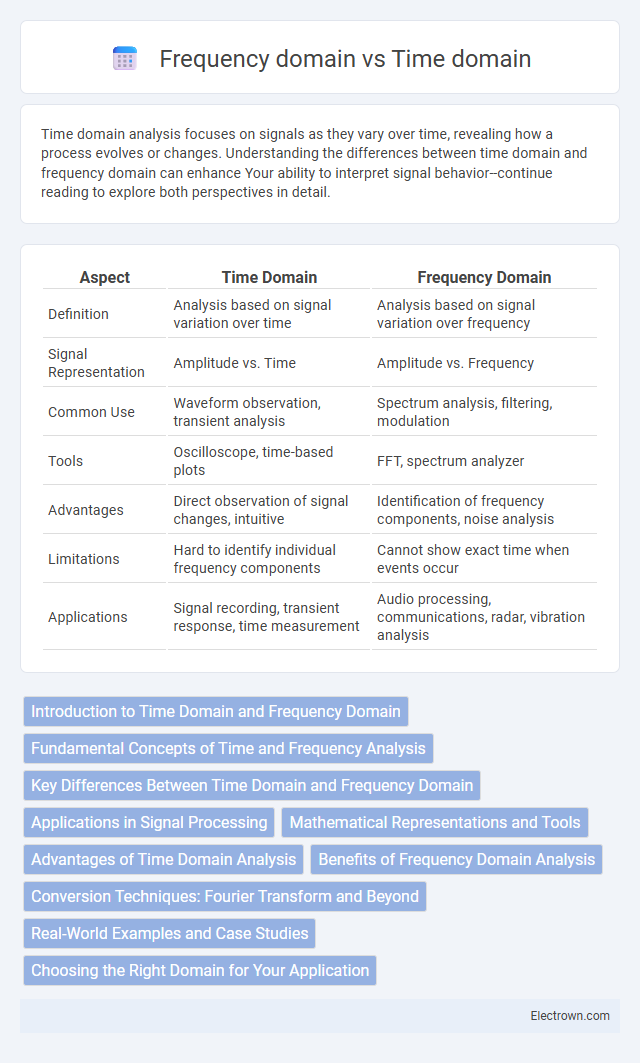Time domain analysis focuses on signals as they vary over time, revealing how a process evolves or changes. Understanding the differences between time domain and frequency domain can enhance Your ability to interpret signal behavior--continue reading to explore both perspectives in detail.
Table of Comparison
| Aspect | Time Domain | Frequency Domain |
|---|---|---|
| Definition | Analysis based on signal variation over time | Analysis based on signal variation over frequency |
| Signal Representation | Amplitude vs. Time | Amplitude vs. Frequency |
| Common Use | Waveform observation, transient analysis | Spectrum analysis, filtering, modulation |
| Tools | Oscilloscope, time-based plots | FFT, spectrum analyzer |
| Advantages | Direct observation of signal changes, intuitive | Identification of frequency components, noise analysis |
| Limitations | Hard to identify individual frequency components | Cannot show exact time when events occur |
| Applications | Signal recording, transient response, time measurement | Audio processing, communications, radar, vibration analysis |
Introduction to Time Domain and Frequency Domain
Time domain analysis examines signals or systems with respect to time, capturing how values change and evolve as time progresses. Frequency domain analysis represents signals by decomposing them into their constituent frequencies, highlighting the spectral content and periodicity of the data. Understanding both domains equips you to select the appropriate approach for signal processing, system characterization, or data analysis tasks.
Fundamental Concepts of Time and Frequency Analysis
Time domain analysis examines signals as they change over time, representing data through amplitude variations at discrete time intervals, which is essential for understanding transient behaviors. Frequency domain analysis transforms these time-based signals using techniques like the Fourier Transform to reveal the signal's spectral components and energy distribution across frequencies. Understanding both domains allows you to comprehensively analyze system behaviors, identify periodicities, and optimize signal processing tasks effectively.
Key Differences Between Time Domain and Frequency Domain
Time domain analysis represents signals with respect to time, showing how amplitude varies at each moment, while frequency domain analysis decomposes signals into their constituent frequencies, revealing spectral components and their intensities. Key differences include the time domain's emphasis on temporal variations and event timing versus the frequency domain's ability to identify periodicities and frequency-specific behaviors. Understanding these distinctions helps You choose the appropriate analysis method for signal processing, system characterization, or data interpretation tasks.
Applications in Signal Processing
Time domain analysis examines signals as they vary over time, making it essential for transient signal detection and real-time system monitoring. Frequency domain techniques, using tools like the Fourier Transform, reveal signal components at various frequencies, enabling noise reduction, filtering, and system identification. Understanding both domains enhances Your ability to design effective filters and perform spectral analysis in communication and audio processing.
Mathematical Representations and Tools
Time domain analysis represents signals as functions of time, capturing how signal amplitude varies moment by moment, using tools like differential equations and time-series plots. Frequency domain analysis transforms signals into their constituent frequencies using mathematical tools such as the Fourier Transform and Laplace Transform, enabling examination of spectral components and system behavior. Your choice between these domains depends on whether temporal evolution or frequency content is more relevant to your signal processing needs.
Advantages of Time Domain Analysis
Time domain analysis provides intuitive insight into how signals or systems behave over specific time intervals, making it easier to observe transient responses and time-dependent phenomena. It allows You to directly measure signal amplitude, duration, and timing, which is essential in applications like digital communications, control systems, and biomedical engineering. This approach is particularly advantageous for capturing non-stationary signals and analyzing real-time data without requiring complex mathematical transformations.
Benefits of Frequency Domain Analysis
Frequency domain analysis offers precise identification of signal components by representing data as functions of frequency, enabling easier detection of periodicities and harmonics compared to time domain methods. This approach simplifies the analysis of complex signals, improving noise filtering and system behavior understanding in applications like communication systems and vibration analysis. By leveraging frequency domain techniques, your signal processing becomes more efficient, allowing for targeted interventions and clearer interpretation of underlying phenomena.
Conversion Techniques: Fourier Transform and Beyond
Conversion techniques between time domain and frequency domain include the Fourier Transform, which decomposes a signal into its constituent frequencies for spectral analysis. Advanced methods like the Short-Time Fourier Transform (STFT) and Wavelet Transform provide enhanced time-frequency localization, enabling detailed examination of non-stationary signals. Understanding these techniques allows you to analyze complex signals more effectively by selecting the appropriate transform based on your signal's characteristics.
Real-World Examples and Case Studies
Time domain analysis is crucial in real-world applications such as ECG signal monitoring, where heartbeats are tracked over time to detect arrhythmias. Frequency domain techniques are widely used in audio engineering to isolate and enhance specific sound frequencies, improving clarity and noise reduction in music production. Case studies in mechanical engineering demonstrate that frequency domain vibration analysis effectively identifies rotational imbalances and bearing faults in machinery, leading to timely maintenance and reduced downtime.
Choosing the Right Domain for Your Application
Selecting between the time domain and frequency domain depends on the specific requirements of your application, such as analyzing transient signals or steady-state behaviors. Time domain analysis is ideal for observing signal changes over time and is crucial for applications like transient response and real-time monitoring. Frequency domain analysis excels in identifying frequency components, making it essential for filtering, noise reduction, and system identification in communications and audio processing.
Time domain vs Frequency domain Infographic

 electrown.com
electrown.com